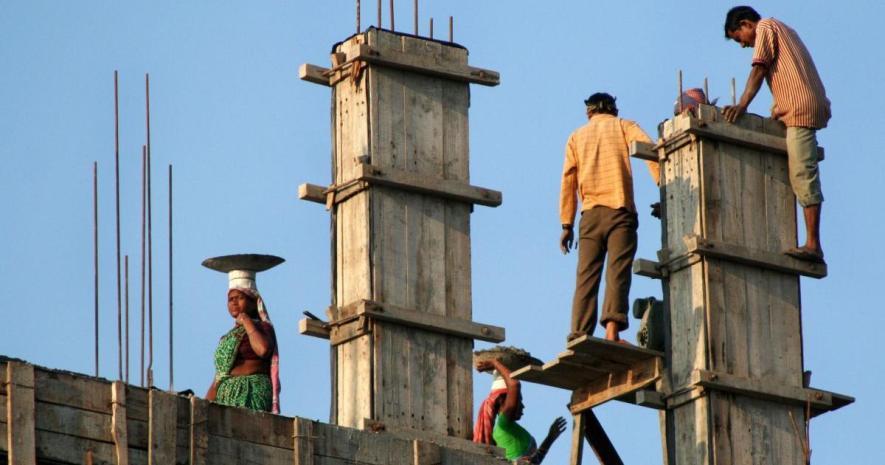India’s Post-COVID Growth: A Mixed Recovery

Image credit: Sabrang India
Today, many celebrate Indian economy's resilience in its post-pandemic recovery. But a closer look at the numbers tell a story of incomplete recovery and structural imbalances that could threaten long-term stability. Two particularly troubling trends have emerged from this latest analysis, both of which deserve careful consideration.
One major trend that stands out is the continued strength of non-productive sectors, such as finance and real estate, in driving growth. This reliance is a double-edged sword. While these sectors do generate substantial revenue, they are termed as “non-productive” since the value absorbed in this sector is merely that which is appropriated from the value created in other sectors, like manufacturing and agriculture (e.g.: financial traders, moving money around to earn large profits in short time can hardly claim to “create” value). They can be understood as the circulatory system of the economy rather than the muscles and organs that do the actual work.
As India’s Finance Minister recently noted, a slow influx in foreign direct investment (FDI) is becoming increasingly apparent, which signals a decline in the economy’s attractiveness to foreign investors. An economy overly reliant on non-productive sectors for growth weakens its productive foundation, ultimately affecting long-term prospects.
Another trend is the sharp rise in real estate investment, possibly leading to a “real estate boom”, re-directing resources away from substantial productivity enhancing investments.
GDP Recovery: An Incomplete Story
To understand how India’s economy has fared in the aftermath of COVID-19, it’s essential to benchmark current data against the pre-pandemic period. Using 2019-20 as the baseline—given that the pandemic’s effects began in the final quarter of that fiscal year—the post-pandemic landscape reveals several challenges.
First, recovery remains incomplete. Since the onset of the pandemic, India’s annual GDP growth rate has averaged just 4.43%, well below the pre-pandemic figure of approximately 7%. The idea of a robust “V-shaped recovery” has yet to materialise. Even per capita income growth remains subdued, at only 3% per year.
Second, non-productive sectors lead the recovery. The finance and real estate sectors have almost recovered to their pre-pandemic growth levels. Since 2018-19, the real estate sector's share of the economy has surged from 8.8% to 10.7%.
Moreover, it is also driven significantly by the construction sector, which is outperforming its pre-pandemic levels – a trend which might appear positive but warrants further attention.
Additionally, manufacturing continues to struggle. The gap between pre- and post-pandemic growth rates for this sector is stark, with its share of the economy declining from 18.3% in 2018-19 to 17.3% in 2023-24. This downturn in manufacturing also extends to employment, a sign of de-industrialisation.
Investment Patterns: The Real Picture
Much has been made of the recovery in Gross Fixed Capital Formation (GFCF) in the post-pandemic period, which reflects investments in physical assets.
However, upon a closer look, the net investment rate (net change in capital stock relative to the economy’s gross value added) remains low, suggesting that growth in real productive investment is still lacklustre. Between 2011-12 and 2018-19, India’s investment rate fell from 24.9% to 22.3%, a decline that has persisted, with the investment rate now standing at only 21.8% in 2023-24.
A key factor behind this slowdown in investment is a reduced rate of profit. The rate of profit was gradually declining since the economic shocks of demonetisation and goods and services tax (GST) in 2016-17. It started to recover after hitting the rock bottom in 2020-21, during the COVID pandemic. But it only improved from 18.1% in 2021-22 to 18.2% in 2022-23, and remains far below pre-pandemic levels of around 20%, contributing to the sluggish rebound in the overall investment rate.
Risks of Real Estate Boom
The combination of stagnant profit rates and lacklustre investment growth has direct implications for labour productivity. An economy that channels its resources into non-productive sectors is unlikely to see robust gains in labour productivity. According to recent data, labour productivity has yet to reach pre-COVID levels and even experienced a decline between 2022-23 and 2023-24.
Data shows that investments by the “household” sector have been leading post-pandemic investment growth. Within this sector, the share of investments directed toward “dwellings” has risen from approximately 60% in 2018-19 to 70% in 2022-23.
Reading this trend, along with the prominence of “construction” and “real estate” sectors in GDP growth, points to a concerning pattern of a “real estate boom”. Surveys show that rising rental rates in cities have spurred affluent households to buy properties, emphasising rent-seeking behaviour, offering little value for the broader economy.
Government-promoted capital expenditure (capex) has only been accompanied by a decline in investments by "public sector corporations", which has kept the share of total public investments stagnant, and points to book-balancing tactics. The heavy reliance on the household sector for investment, especially in real estate, suggests a shift away from productivity-oriented investment.
A Path Forward
India’s post-pandemic growth trajectory, marked by slow recovery in labour productivity, declining manufacturing share, and dominance of non-productive sectors, indicates a need for addressing structural issues.
In the short run, the government can truly prioritise boosting public investment in sectors that enhance productive capacity rather than relying solely on superficial fiscal adjustment. In particular, government consumption should play a larger role in driving GDP growth, which has been hampered by inadequate demand stimulus. Following a crisis, it’s essential for the government to invest in demand-generation, which supports recovery across sectors.
In the longer run, a return to economic planning is essential to foster sustainable growth. By strategically guiding investments toward productive sectors and ensuring a balanced distribution across sectors, the government can prevent issues of overproduction and structural imbalance. A balanced approach to economic planning could revitalise sectors that contribute to job creation, technological innovation, and long-term stability.
In sum, the post-pandemic recovery highlights the risks of a growth path heavily reliant on neoliberal policies.
The writer is a PhD Scholar in Centre for Development Studies, Thiruvananthapuram. The views are personal.
Get the latest reports & analysis with people's perspective on Protests, movements & deep analytical videos, discussions of the current affairs in your Telegram app. Subscribe to NewsClick's Telegram channel & get Real-Time updates on stories, as they get published on our website.
























